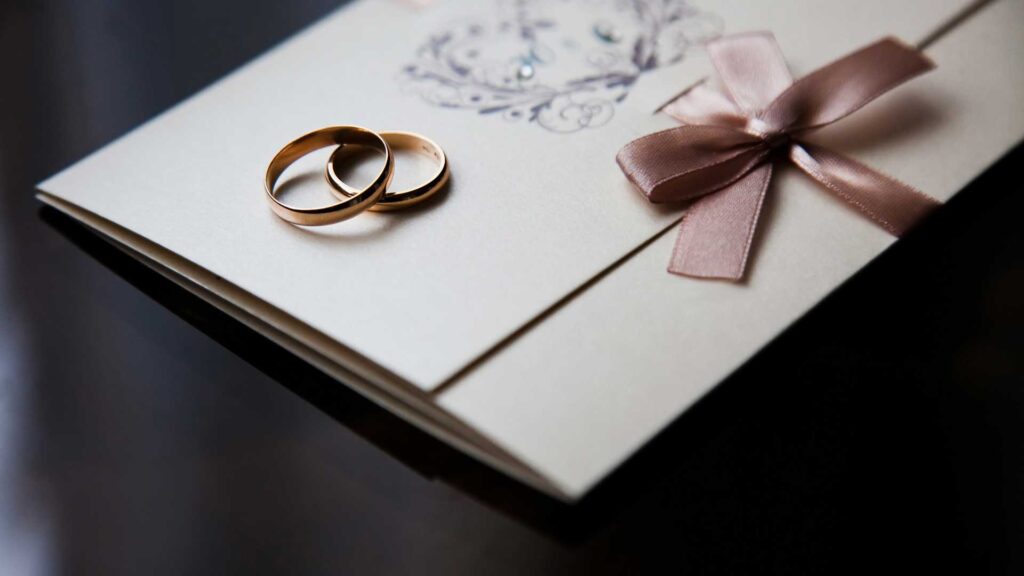Planning when to send your wedding invitations can feel like a daunting task, but getting the timing just right is essential for a smooth and stress-free celebration. From save-the-dates to formal invites, the timing plays a crucial role in setting the tone for your wedding and ensuring your guests have enough time to prepare. Whether you’re tying the knot locally or hosting a destination wedding, understanding the right timeline will help avoid last-minute chaos. This guide will walk you through the best timeframes for sending invitations, share expert tips, and highlight key considerations for a flawless planning experience.
Why Sending Your Wedding Invitations on Time is Crucial
Setting the Tone for Your Wedding Day
The timing of your wedding invitations isn’t just about logistics—it sets the stage for the entire wedding experience. When we planned our own wedding, my partner and I were determined to set the tone early on. We decided on an elegant, formal celebration at Vogue Ballroom, so we chose formal wedding invitations to match. Getting the timing right helped establish a sense of anticipation for our guests, making them excited and ready to celebrate with us.
The Impact of Timing on Guest Attendance
You might think that sending wedding invitations early is enough, but trust me, it’s all about the right timing. The earlier you send them, the more likely your guests are to RSVP and commit. When I helped a friend plan her wedding, she sent her invitations too late and had to follow up with guests, which made things stressful. Guests need time to secure accommodation, book flights, and even take time off work. By giving them ample notice, you’ll get better responses and fewer last-minute surprises.
The Complete Timeline: When to Send Save the Dates
Save the Dates: Why They Matter
Save-the-dates are often the first communication your guests will receive about your wedding. Sending them out early, especially for destination weddings or weddings with lots of interstate or international guests, ensures that your guests have time to make arrangements. When we had our wedding, I made sure to send out save-the-dates well in advance—this gave our international friends the time they needed to get their ducks in a row.
Ideal Timeframe for Sending Save the Dates
As a general rule, it’s best to send save-the-dates 6 to 12 months before the big day. If you’re having a local wedding, you can send them closer to the six-month mark. But for destination weddings, or if many of your guests are coming from overseas, send them closer to 8-12 months in advance. I’ve seen couples who try to skip the save-the-dates, but honestly, they end up scrambling when guests struggle to make last-minute plans. Save-the-dates help ensure people don’t book other commitments on your wedding day!
Special Considerations: Destination Weddings and International Guests
Planning a wedding abroad? Give your international guests plenty of notice—around 8 to 12 months before the wedding is ideal. When we got married, some of our overseas guests needed extra time to sort out flights and accommodation, and a few needed help navigating visa requirements. The earlier you send save-the-dates, the easier it is for everyone to get their travel plans in order.
When to Send Formal Wedding Invitations
Sending Invitations After Save-the-Dates: The Perfect Window
Once your save-the-dates are out, it’s time to focus on your formal wedding invitations. If you’ve already sent save-the-dates, aim to send your formal invitations 6 to 8 weeks before the wedding date. This gives guests enough time to make arrangements and RSVP without losing interest. Some couples I’ve worked with chose to send their invites a bit earlier—say 8 to 10 weeks—which allowed a little more breathing room for last-minute changes.
For Weddings Without Save-the-Dates: Sending Invitations Earlier
If you haven’t sent save-the-dates (and trust me, that can happen), you’ll want to send your wedding invitations earlier—around 4 to 6 months before the event. Without a save-the-date as a pre-warning, guests will need extra time to plan. I helped a couple in Melbourne who didn’t send save-the-dates, and we had to push the invitations out about 5 months before the wedding. It worked out fine, but it was a tighter timeline. The earlier, the better!
Destination Weddings: A Longer Lead Time
Destination weddings require even more time for guests to plan. For these types of weddings, send your invitations 3 to 4 months in advance. This gives your guests ample time to book flights, secure accommodation, and take time off work. One couple I worked with got married in Bali, and we sent invitations 6 months ahead. That way, their international guests had enough time to find the best flights and plan their stay.
Busy Wedding Seasons: Why You Need to Send Invitations Early
If you’re getting married during peak wedding season, like Melbourne’s summer or during the holidays, you’ll need to send invitations earlier than usual. I always recommend 9 weeks in advance during these busy times. Weddings around major holidays or peak seasons are popular, and people’s calendars fill up fast. The earlier you get those invites out, the better chance you have of securing the guests you want.
What Should Your Wedding Invitation Include?
Essential Details Every Wedding Invitation Should Have
At the heart of your wedding invitation is the need for clarity. When I helped a friend craft her wedding invitations, we made sure to include all the key details: the couple’s names, the wedding date and time, the venue(s), attire requests, and RSVP instructions. Keep the wording simple and clear to avoid overwhelming your guests.
Here’s a quick checklist of what your invitation should include:
- Names of the couple
- Date and time of the wedding
- Ceremony and reception venue (or just the city if the venue is still in the works)
- Attire requests (if any)
- RSVP instructions with the response deadline
Also, don’t forget to proofread! I once worked with a couple who missed a small typo on their invitations, and it caused a minor hiccup with some guests. Double-checking the details makes all the difference!
Customising Wedding Invitations for a Personal Touch
This is where you get to have some fun with your wedding invitations. Do you want to add a personal touch? Maybe your invitation suite includes a heartfelt quote from your favourite poem or a special design element that reflects your wedding’s theme. For our wedding, we added a watercolour illustration of our venue to our invitations. It was a small detail, but it made them feel unique and personal to us. Whether it’s rustic wedding invitations with natural elements or vintage wedding invitations with an antique feel, make sure your invites reflect your personality and the tone of your wedding.
RSVP Deadlines: When to Request Responses
Setting the Perfect RSVP Deadline
Now that your invitations are out, it’s time to focus on your RSVPs. A typical RSVP deadline is set around 2 to 3 weeks before the wedding day. This allows you enough time to get a final headcount for your caterer, rental company, and other vendors. I always recommend setting your RSVP date early enough so you have a cushion to follow up with guests who might forget to respond.
For Destination Weddings: An Earlier RSVP Deadline
For destination weddings, you’ll want to request RSVPs at least 2 months in advance. This gives your guests enough time to finalise travel plans and allows you to better estimate the number of people who will attend. I once worked with a couple who got married in the Hunter Valley and had many interstate guests—they set their RSVP deadline 8 weeks before the wedding, which worked out well.
How to Encourage Timely RSVPs
Follow-up is key. Don’t be afraid to chase up guests who miss the deadline. You can do this by calling, emailing, or sending a gentle reminder through your wedding website. I had a couple who added a reminder note on their wedding website—just a friendly nudge for anyone who hadn’t replied yet.
Digital vs. Printed Invitations: What’s the Best Timing?
Timing Considerations for Digital Invitations
In today’s digital age, more and more couples are opting for digital wedding invitations. The benefit? Speed. Digital invites can be designed and sent out almost immediately, which is a huge advantage if you’re working with a tight timeline. When my friend was planning her wedding on a short timeline, she opted for digital invitations. We designed them in just a few days, and they were in her guests’ inboxes by the end of the week. This gave them enough time to RSVP and get everything sorted, without the long wait for printed invitations.
That said, while digital invitations are convenient, they can sometimes get lost in a guest’s inbox. In a world full of emails, an invitation might easily slip through the cracks. If you go the digital route, just be sure to follow up with a personal message or reminder.
Preparing for Printed Invitations: Allow Extra Time
Printed invitations, on the other hand, are a more traditional choice that adds a sense of elegance to the wedding. If you’re opting for this, you need to plan ahead. The process of designing, printing, and assembling printed invitations can take weeks. I worked with a couple last year who wanted custom wedding invitations, and we started the design process six months before their wedding to ensure everything was ready on time.
You’ll need to consider:
- Design and customisation time: This can take several weeks, especially if you’re working with a custom designer.
- Printing time: Once the design is finalised, printing usually takes about 2-3 weeks.
- Assembly and postage: Assembling the invites, adding stamps, and sending them out can take another week or two.
Digital vs. Printed: Which One Works Best for Your Wedding?
Choosing between digital and printed invitations ultimately comes down to your style and timeline. If you have ample time and love the idea of guests receiving a keepsake, printed invitations are the way to go. But if you’re in a hurry or want to reduce costs, digital invitations can be a quick and eco-friendly alternative. For our wedding, we went with printed invitations because it fit the formal nature of the event, but I always encourage couples to think about their priorities—timing, budget, and personal style.
Other Wedding Stationery and Invitations
Engagement Party and Bridal Shower Invitations: How to Time Them
Your wedding day isn’t the only event where invitations are required—engagement parties and bridal showers also need a solid timeline. For an engagement party, send invitations 4 weeks in advance. This gives your friends and family enough time to clear their schedules, but not so much time that they forget about it.
Bridal shower invitations can be sent 6 months before the wedding. This gives the guests enough notice to plan and to buy gifts, without feeling rushed. One couple I worked with had a bridal shower right before the wedding, and they made sure to send invites well in advance, which helped everyone plan their attendance. It also allowed the bride to organise the final details with her bridesmaids without stress.
Thank You Cards: When to Send Them After the Wedding
The wedding is over, but the thank-you cards are just as important. It’s customary to send thank-you cards within 2 to 6 weeks after the wedding. Many couples aim for two months as a good balance. This gives you enough time to recover from the wedding, get settled back into life, and put together thoughtful notes to express your appreciation.
When we got back from our honeymoon, my partner and I sat down to write our thank-you cards together. It wasn’t rushed, and it allowed us to reflect on how grateful we were for each guest who had attended and gifted us something special. Don’t feel pressured to get them out too quickly, but make sure you send them within that two-month window to show your appreciation.
Perfect Timing for Your Wedding Invitations
Actionable Advice for Stress-Free Wedding Planning
The key to stress-free wedding invitations is planning ahead. Give yourself and your guests plenty of time to prepare, and make sure to account for any special circumstances, such as destination weddings or international guests. Here’s a quick recap:
- Save-the-dates should go out 6-12 months in advance, especially for destination weddings or overseas guests.
- Wedding invitations should be sent 6-8 weeks before the wedding if save-the-dates have been sent; otherwise, aim for 4-6 months if save-the-dates were skipped.
- RSVP deadlines should be set at least 3 weeks before the wedding to ensure a smooth process for vendors and seating arrangements.
- Consider digital vs. printed invitations based on your timeline and personal style.
By following these guidelines, you’ll make sure everything runs smoothly—and your guests will appreciate the clarity and ample notice.
Let’s Get Straight to the Point
Timing is key when sending wedding invitations. Start with sending save-the-dates 6-12 months in advance, especially for destination weddings or international guests. Formal invitations should go out 6-8 weeks before the wedding if save-the-dates have been sent, or 4-6 months in advance if not. Set RSVP deadlines about 2-3 weeks before the wedding. Digital invitations offer speed, while printed ones add a personal touch but take longer to prepare. Don’t forget to send thank-you cards within 2-6 weeks after the wedding. Planning ahead will keep everything stress-free and ensure your guests have enough time to prepare.




